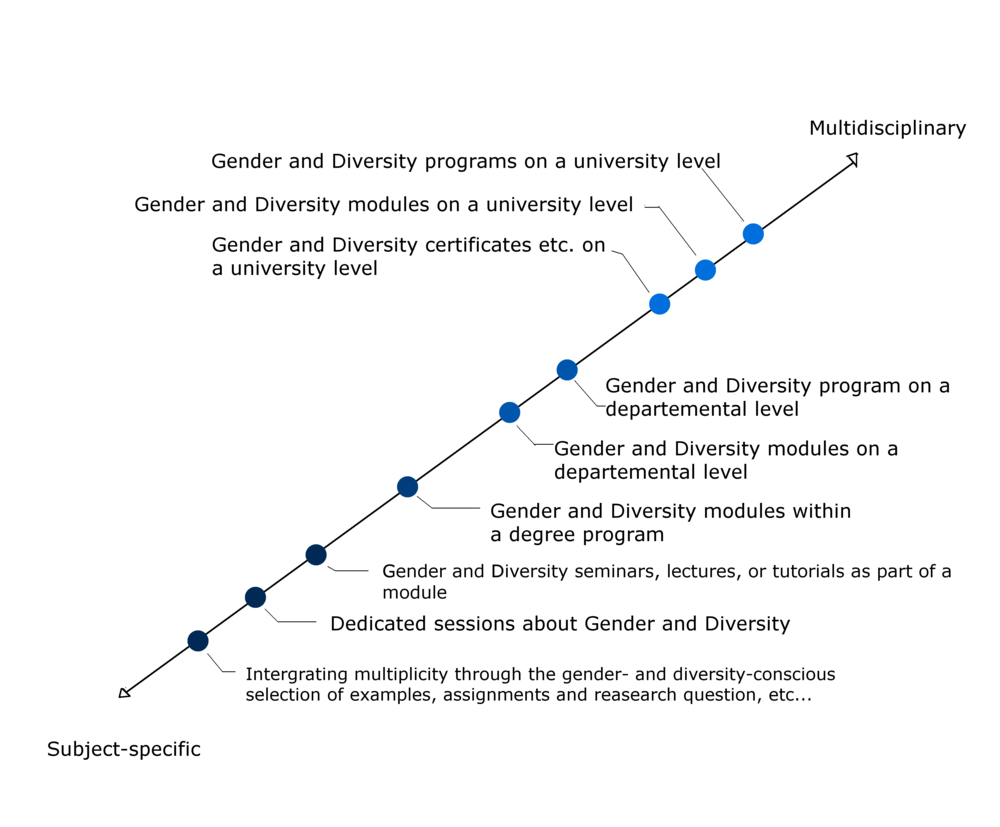Implementation Options
Implementation Options
... In Courses
This graphic illustrates various layers at which gender and diversity can be anchored in your teaching. They range from fully transdisciplinary to highly subject-specific. Different aspects and conceptions of Gender and Diversity Studies also fall within this range.
On the one side, there are transdisciplinary degree programs in Gender or Diversity Studies. These programs refer to Gender and Diversity Studies as an “interdisciplinary or transdisciplinary discipline.”
On the other side, other disciplines emphasize approaches specific to their field, such as pharmaceutics, physics, or the social sciences – although their findings are not independent of those of interdisciplinary Gender and Diversity Studies. More at Discipline-Specific Entry Points. In between the two extremes, there are options for integrating this subject matter into degree programs and academic departments.
The responsibility for these various layers is shared out between several different structural actors in the university. Their existence and cooperation are crucial to ensure that Gender and Diversity Studies is represented in the broad strokes of university policy as well as in the small-scale, routine details of teaching. The following elements are especially important in order to anchor gender and diversity structurally in research and teaching:
- Specialized professorships in the field of Women’s and Gender Studies as well as Diversity Studies
- Professorships that specify Women’s and Gender Studies or Diversity in their job descriptions but not in their stated field
- Research assistants with emphases in a gender-related or diversity-related research area
- Other academic positions working on research projects with emphases related to gender and diversity
In the graphic above, the roles that affect direct teaching work are underlined in red. Moving upwards, the layers are more associated with academic departments and university-wide institutions and their players. As university resources diversify, they often embrace multiple layers and are less formally specialized, so this representation should be taken as a simplified demonstration: these are not fixed, immutable categories.
Implementation Options
All strategies for implementing gender and diversity on the level of microdidactics can be implemented in any type of teaching and any subject and are therefore especially adaptable to various fields. One element of this is language and communication; more on these in the Language and Skills sections. Another element is your use of didactic methods. All of these elements can also be employed without a specific tie-in to content about gender and diversity.
The gender- and diversity-conscious selection of examples, assignments, and research questions is more closely related to learning content. This includes, for example, paying attention to gender and diversity as you design research-based and problem-based learning, or selecting literature that reveals a variety of academic and social perspectives towards a research subject.
You can find more suggestions for discipline-specific ways to design gender- and diversity-conscious teaching under Content Connections for Every Field, Gender and Diversity Studies, and the Discipline-Specific Examples.
With this approach, gender and diversity can be integrated as a focus of one or more individual class sessions of a seminar, lecture, or tutorial. However, it is advisable to integrate these sessions seamlessly into the course and repeatedly refer back to them – do not treat them in isolation. This way, gender and diversity aspects are just one perspective among many towards the subject of the course.
Examples:The class session on “Care Chains as Part of Intra-European Labor Migration” as part of a seminar on EU foreign policy; the class session on “Emma Noether’s Ideal Theory of Commutative Algebra” in a mathematics course; “Stereotypes in School textbooks” in a teacher-training course.
Aspects of gender and diversity can be the subject of separate seminars, lectures, or tutorials offered as part of a module which may or may not have an emphasis on the field of gender and diversity itself.
You can find examples of this type of integration at Freie Universität Berlin’s AGENDA, published each semester by the Margherita von Brentano Center.
Gender and diversity can also be treated as a separate field of teaching and research with a variety of course types within a degree program, for example as a module.
The following modules at Freie Universität Berlin serve as examples of such integration:
- “D4: Culture – Gender – Media” and “Gender, Diversity und Sexuelle Vielfalt im Fachunterricht” (Gender, Diversity, and Sexual Diversity in Subject Classes) in the Lehramt für Gymnasien (Grammar School Teachers’ Training) master’s program
- “Negotiating Gender: Constructions, Representations, Theories” in the MA in English Studies: Literature – Language – Culture
- “D: Geschlechterverhältnisse, Lebensformen, Transformationen” (D: Gender Relations, Lifestyles, Transformations) in the MA in Interdisziplinäre Lateinamerikastudien (Interdisciplinary Latin American Studies).
In this approach, gender and diversity are the subjects of modules developed specially for an academic department.
Some examples of this approach are the general professional skills (ABV) courses at Freie Universität Berlin in the area of gender and diversity that are situated directly in the academic departments, such as the “BWL und Gender” (Business Studies and Gender) module in the ABV division of economics (link). Conceivably, there could also be modules about gender and diversity that are part of multiple degree programs in a department (e.g., modules for teacher training and bachelor’s programs).
In this approach, gender and diversity are the central subject of a degree program that has an interdisciplinary orientation but ranges among related groups of fields – either at an academic department, in a faculty, or in cooperation with multiple academic departments. The teaching and research methods may vary, but they are similar and the specialized discourse frequently overlaps. The program can therefore comprise a mixture of interdisciplinary, partly integrated, and specific/explicit approaches.
An example of such integration is the upcoming master’s program in ‘Gender and Diversity’ at Freie Universität Berlin’s department of political and social science or the former master’s program in ‘Gender and Diversity Competence.’ The course syllabus often include courses from the participating departments and, in turn, add specific perspectives from Gender and Diversity Studies to those departments’ catalog.
Certificates in gender and diversity or associated specialties, which are often interdisciplinary, can be an option for incorporating this subject matter without a degree program. In these certificate courses, students can acquire knowledge and skills in the field of interdisciplinary Gender and Diversity Studies – either in addition to or in specific connection to their field or research area. The certificates, such as Gender Pro Mint at TU Berlin (link), the Gender and Diversity Certificate at TU Ilmenau (link), and the Gender Diversity Certificate at the Leuphana University of Lüneburg (link) have many possible links to regular courses of study.
Like the certificates, gender and diversity programs can also be organized as pan-university modules, as at Freie Universität Berlin. As part of the university’s General Professional Skills Courses (Allgemeine Berufsvorbereitung, ABV), the Margherita von Brentano Center offers three modules in the skill area of gender and diversity competence:
- Module: “Gender and Diversity: Core Social Categories in the 21st Century”
- Module: “Gender, Diversity, and Gender Mainstreaming”
- Module: “Diversity Management”
You can find out more about what the Margherita von Brentano Center is currently offering on its website.
Another interdisciplinary method for integrating gender and diversity into research and teaching is the establishment of independent, often highly interdisciplinary degree programs that students can pursue separately or in combination with certain specialized subjects.
Examples of this mode of teaching and research include the BA/MA programs at Humboldt-Universität zu Berlin’s Center for Transdisciplinary Gender Studies[BL1] , the BA/MA programs at the Gender Studies Coordination Office of the University of Göttingen, and the BA program in Gender and Diversity Studies at Rhine-Waal University of Applied Sciences. You can find more in the compilation of Degree Programs in Women’s and Gender Studies in German-Speaking Countries at the Center for Transdisciplinary Gender Studies and from the Women’s and Gender Research Network NRW.
Version April 2017. Unless otherwise stated, this content is licensed under a Creative Commons Attribution-Share Alike 4.0 International licence.


